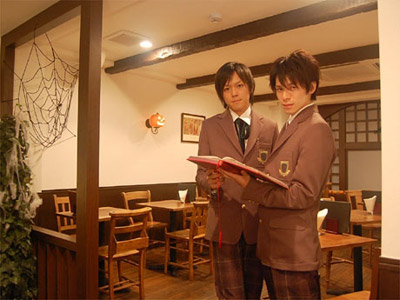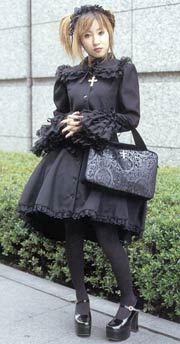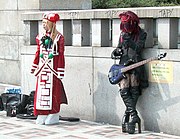Cosplay (コスプレ ,kosupure), short for "costume play", is a type of performance art whose participants outfit themselves, with often-elaborate costumes and accessories, as a specific character. Characters are usually sourced in various Japanese and East Asian media, including manga, anime, tokusatsu, comic books, graphic novels, video games, and fantasy movies. Other sources include performers from J-pop, J-rock, Visual Kei, fantasy music stories (such as stories by the band Sound Horizon), novels, and objects from cyberspace or the real world that are unique and dramatic (especially if they have or can be given an anthropomorphic form).
Cosplay participants ("cosplayers") form a subculture centered around wearing their costumes and reenacting scenes or inventing likely behavior inspired by their chosen sources. In some circles, the term cosplay has been broadened to include simply wearing a costume, without special consideration given to enacting characters in a performance context.
Cosplay venues
Cosplay can be seen at public events such as video game shows, as well as at dedicated cosplay parties at nightclubs or amusement parks. It is not unusual for Japanese teenagers to gather with like-minded friends in places like Tokyo's Harajuku district to engage in cosplay. Since 1998, Tokyo's Akihabara district has contained a large number of cosplay cafés, catering to devoted anime and cosplay fans. The waitresses at such cafés dress as game or anime characters; maid (or meido) costumes are particularly popular.
Possibly the single largest and most famous event attended by cosplayers is the semiannual doujinshi market, Comiket. This event, held in summer and winter, attracts hundreds of thousands of manga otaku and many thousands of cosplayers who congregate on the roof of the exhibition center, often in unbearably hot or cold conditions.
Cosplayers in Japan refer to themselves as reiyâ (レイヤー ); pronounced "layer". Those who photograph players are called cameko, short for "Camera Kozo" or "Camera Boy". The cameko give prints of their photos to the players as gifts. Tensions between players and cameko have increased due to perceived stalker-like behavior among some obsessive males who push female cosplayers to exchange personal email addresses or do private photo sessions. One result of this has been a tightening of restrictions on photography at events such as Comiket.
While cosplay at fan events in Japan is thought to have originated in 1978, one should not be confused with the idea that cosplay is considered typical behavior in Japan. While some do attend cosplay functions that are held in districts such as Akihabara, most Japanese people find cosplay to be rather silly.
Cosplay costumes
Cosplay costumes are radically different from typical Halloween costumes. Because the object of cosplay is to literally to become one's character, the intricate details of the costume's construction are critical. Costumes must meticulously adhere to the designs of the characters' attire, and even more generic costumes are often elaborately artistic. Rigorous attention to detail may include ensuring the seams are aligned properly and finished, thread colors are appropriate, and fabric colors precisely match the character and their attire. Some cosplayers will buy their costumes from talented artists, while others may spend months creating the perfect cosplay outfit.
Because the costumes are so elaborate, like-minded people gather to see others' costumes, show off their own elaborate handmade creations, take lots of pictures, and possibly participate in best costume contests at different cosplay events. Countless tutorials have also been created all over the internet by cosplayers to aid members of the community.
Cosplay trends
A recent trend at Japanese cosplay events is an increase in the popularity of non-Japanese fantasy and science fiction movie characters, perhaps due to the international success of such films as The Matrix, Star Wars and Lord of the Rings. Characters from the Harry Potter films have a particularly high number of female fans in Japan, with female cosplayers playing either male or female characters, Draco Malfoy being an extremely popular choice.[citation needed]
Cosplaying as characters of the opposite sex is called "crossplay", and cosplaying as characters who dress as the opposite sex is called "cross-dressing". The main reason that people do “crossplay” or “cross-dressing” is because in anime there is an abundance of bishounen (beautiful youths), who are very attractive and feminine-looking male characters. Therefore, in the reality, females can often act as these characters better than the males. “Crossplay” and “cross-dressing” often coincide, but since some Japanese characters cross-dress to start with, it is possible to do one without the other.
For example, a female cosplayer cosplaying as a male character would be cross-dressing and crossplaying. However, a female cosplayer dressing as someone like Mana (male artist from the Visual Kei band Malice Mizer known for dressing in female clothes) would be crossplaying, but not cross-dressing; and a male cosplayer also cosplaying as Mana would be cross-dressing, but not crossplaying.
A small niche group in the crossplaying field are dollers, a subset of kigurumi cosplayers; usually male, they wear bodysuits and masks to transform fully into female characters.
By the late 1980s, rather than cosplay being a chance to roleplay as a favourite character, it was a chance to be seen. A new kind of cosplayer emerged - a cosplayer who attended events not to participate, but to be photographed. Also, photographers came to take photographs of the cosplayers, several of those photographers were from adult magazines.
Cosplay magazines
In Japan, there are two cosplay magazines, Cosmode(コスモード) and Dengeki Layers (電撃Layers). Cosmode has the largest share in the market. An English digital version of Cosmode has been created.
There are also two emerging cosplay magazines outside of Japan, the USA's AniCoz and Mexico's CosplayWorld.
Cosplay industry
As the cosplay culture becomes more dominant in the Japanese street fashion and Japanese popular culture, many businesses are seeking opportunities to profit from this new phenomenon. The number of people who endorse cosplay as a form of hobby grow rapidly each day, the total amount of money devoted to this hobby also grows exponentially.
Commodity market
Since the design of the clothing is originated from mostly fictional characters from manga, anime, tokusatsu, comic books, graphic novels, video games, and fantasy movies, the design itself is not copyrighted by the author or the maker of these forms of publication. Therefore, small manufacturers are able to take advantage of this by simply produce and sell packaged set costumes to cosplay fans. Even though the hardcore cosplayers make their own costumes, most of the cosplay fans purchase the costume. The relatively cheap ones are sold around 70 dollars and the expensive ones sold well over 600 dollars. The cosplay accessories and wigs are also essential to the experience of cosplay as well as to the business. In most cases less than 50 dollars, the wigs and accessories are a lot more affordable and fun to collect.
Modeling market
In a more abstract sense, the cosplay concept has affected the Japanese advertising industry a lot more than its impact on the commodity market. As this increasingly popular hobby is slowly becoming a household name, various print media have recently featured cosplayers. This booming new demand has many in the modeling industry scrambling to hire cosplayers as they are considered fictional characters in flesh.
Cosplayers are now being pursued by many companies, like ADV Films, for promotional and print opportunities that were previously occupied by agency models. Their ability to re-create their chosen characters with accuracy and vitality is what's fueling the switch from the standard promotional models of the past that were just there to attract attention. This recent trend has even become apparent in such venues as E3 occupied by a mix of both agency girls and cosplayers.
Japan's burgeoning anime industry has long been home to the professional cosplayers since the rise of Comiket, Tokyo Game Show, and other such powerhouse conventions. The interest to develop such a profession has long been desired, but unfulfilled until recent years. The fan base is matured enough now to support the market of this flamboyant occupation.
[Source : http://wikipedia.org]
Tags : Fashion, Street Style, Harajuku Style, Visual Kei, Gothic Lolita, Decora & Kewaii, Ganguro & Kogal, Cosplay, Harajuku Indonesia.























